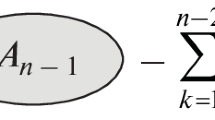Abstract
For the effective potential in the leading logarithmic approximation, we construct a renormalization group equation that holds for arbitrary scalar field theories, including nonrenormalizable ones, in four dimensions. This equation reduces to the usual renormalization group equation with a one-loop beta-function in the renormalizable case. The solution of this equation sums up the leading logarithmic contributions in the field in all orders of the perturbation theory. This is a nonlinear second-order partial differential equation in general, but it can be reduced to an ordinary one in some cases. In specific examples, we propose a numerical solution of this equation and construct the effective potential in the leading logarithmic approximation. We consider two examples as an illustration: a power-law potential and a cosmological potential of the \(\tan^2\phi\) type. The obtained equation in physically interesting cases opens up the possibility of studying the properties of the effective potential, the presence of additional minima, spontaneous symmetry breaking, stability of the ground state, etc.





Similar content being viewed by others
References
S. Coleman and E. Weinberg, “Radiative corrections as the origin of spontaneous symmetry breaking,” Phys. Rev. D, 7, 1888–1910 (1973).
R. Jackiw, “Functional evaluation of the effective potential,” Phys. Rev. D, 9, 1686–1701 (1974).
N. N. Bogoliubow and O. S. Parasiuk, “Über die multiplikation der Kausalfunktionen in der Quantentheorie der Felder,” Acta Math., 97, 227–266 (1957).
K. Hepp, “Proof of the Bogolyubov–Parasiuk theorem on renormalization,” Commun. Math. Phys., 2, 301–326 (1966).
W. Zimmermann, “Convergence of Bogoliubov’s method of renormalization in momentum space,” Commun. Math. Phys., 15, 208–234 (1969).
N. N. Bogoliubov and D. V. Shirkov, Introduction to the Theory of Quantized Fields, John Wiley & Sons, New York (1980).
L. V. Bork, D. I. Kazakov, M. V. Kompaniets, D. M. Tolkachev, and D. E. Vlasenko, “Divergences in maximal supersymmetric Yang–Mills theories in diverse dimensions,” JHEP, 11, 059, 38 pp. (2015).
D. I. Kazakov, L. V. Bork, A. T. Borlakov, D. M. Tolkachev, and D. E. Vlasenko, “High energy behaviour in maximally supersymmetric gauge theories in various dimensions,” Symmetry, 11, 104, 29 pp. (2019).
D. I. Kazakov, “RG equations and high energy behaviour in non-renormalizable theories,” Phys. Lett. B, 797, 134801, 5 pp. (2019).
R. Kallosh and A. Linde, “Universality class in conformal inflation,” J. Cosmol. Astropart. Phys., 2013, 002 (2013); arXiv: 1306.5220.
Y. Akrami, R. Kallosh, A. Linde, and V. Vardanyan, “Dark energy, \(\alpha\)-attractors, and large-scale structure surveys,” J. Cosmol. Astropart. Phys., 2018, 041 (2018); arXiv: 1712.09693.
C. F. Curtiss and J. O. Hirschfelder, “Integration of stiff equations,” Proc. Natl. Acad. Sci. USA, 38, 235–243 (1952).
Funding
This work was supported by the Russian Science Foundation (grant No. 21-12-00129).
Author information
Authors and Affiliations
Corresponding author
Ethics declarations
The authors declare no conflicts of interest.
Additional information
Translated from Teoreticheskaya i Matematicheskaya Fizika, 2023, Vol. 217, pp. 533–542 https://doi.org/10.4213/tmf10483.
Rights and permissions
About this article
Cite this article
Kazakov, D.I., Tolkachev, D.M. & Yahibbaev, R.M. Quantum corrections to the effective potential in nonrenormalizable theories. Theor Math Phys 217, 1870–1878 (2023). https://doi.org/10.1134/S0040577923120061
Received:
Revised:
Accepted:
Published:
Issue Date:
DOI: https://doi.org/10.1134/S0040577923120061



